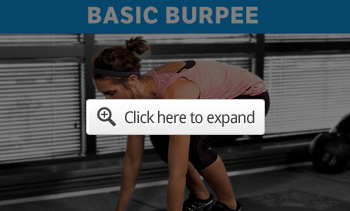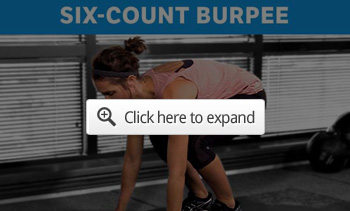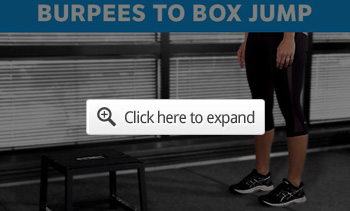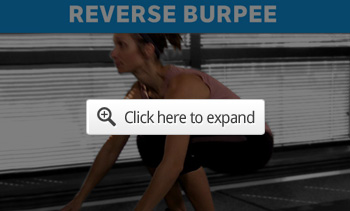How to Do Burpees Properly
STORY AT-A-GLANCE
- The burpee was named after Royal Huddleston Burpee, a physiologist from New York City. He invented this move in 1939 when he was still a Ph.D. candidate in applied physiology at Teacher’s College, in Columbia University
- Burpees may lead to various benefits, as it’s a full-body, calorie-burning move that works as both an aerobic and anaerobic maneuver
- If you want to challenge yourself, you can try doing burpees using a BOSU ball or performing them by a wall instead of assuming a plank position
Although they are one of the most ideal exercises you can perform, burpees are considered one of the hardest bodyweight exercises, so a lot of people tend to avoid performing them.
If you're confused as to how adding burpees to a workout can help you achieve your fitness goals, this guide will help give you a good picture. Learn what burpees are good for, how to do proper burpees and what other burpee variations you can perform. In no time, you may be able to share your knowledge with someone who wants to do this move to improve their overall well-being.
What Is a Burpee?
Burpees, also known as a squat thrust and military burpee, are a bodyweight exercise that targets different body parts, such as the arms, shoulders, legs, chest and more. Burpees are extremely advantageous, since they may be done anywhere and anytime without any cost. Plus, you won't need special equipment when you do this move, unless you do different burpee variations, as your fitness level allows.
But why do they call this move a "burpee?" This movement was actually named after Royal Huddleston Burpee, a physiologist from New York City. He invented this move in 1939 when he was still a Ph.D. candidate in applied physiology at Teacher's College, Columbia University.
HuffPost notes that he intended this four-count move to be used as a quick and accurate way to evaluate a person's fitness.1 Because of burpees' effectiveness, in 1940, this exercise was incorporated in fitness tests for men enlisting in the U.S. military.2
3 Burpees Benefits to Your Body
Burpees are an exercise that may lead to various benefits, as it's a full-body, calorie-burning move that works as both an aerobic and anaerobic maneuver. It can be incorporated into Peak Fitness high-intensity training workouts. Burpees may also assist in honing balance and coordination, promoting better metabolism and:3
- Helping build strength — A burpee workout lets you push and lift your own weight, raise your endurance and eventually build muscle in the process.
- Working as well as a cardiorespiratory4 workout — Burpees may allow you to increase your heart rate to target levels.
- Burning more fat — Performing high-intensity exercises like burpees may prompt the body to burn more fat compared to conventional strength training.5 As a result, you exercise for only around half the time you would with strength training, but still burn just as much fat.
Some studies have touched on the other benefits of burpees too. According to a study in the journal Applied Physiology, Nutrition, and Metabolism,6 subjects who underwent low volume interval-style training and whole-body aerobic resistance training had better cardiovascular fitness and skeletal muscle endurance. Some of the workouts the subjects had to perform included burpees, jumping jacks, mountain climbers or squat thrusts.
In a separate study published in the Journal of Strength and Conditioning Research,7 researchers noted that a high-intensity intermittent calisthenics (HIC) protocol, which included burpees, may induce vigorous cardiorespiratory and perceptual responses. This type of workout may also lead to physiological adaptations and performance improvements similar to results derived from a sprint interval cycling (SIC) workout.
What Muscles Do Burpees Work?
Burpees target your legs, arms, shoulders, chest, back, abs, glutes, quads and hamstrings. Strength and conditioning specialist and doctor of physical therapy Laura Miranda notes that when burpees are done properly, "… they really don't leave a single muscle group behind."8
To ensure that you can properly work these muscle groups, you should know how to do burpees correctly. If you are a beginner, don't worry, as there are instructions on how you can perform burpees without injuring yourself.
How Do You Do a Burpee?
When Burpee first invented this particular move, there were four steps; hence, it was called a four-count burpee. Here's how to do a basic burpee:
- From a standing position, drop into a squat and place both hands on the ground.
- Bring palms to the floor and extend feet backward in one swift motion to assume a front plank position.
- In one quick motion, return to the squat position and then to a standing position.

Most people, on the other hand, are familiar with the six-count burpee.9 Follow these instructions if you're going to do this type of burpee:
- From a standing position, drop into a squat and place both your hands on the ground.
- Bring your palms to the floor and extend feet backward in one swift motion to assume a front plank position.
- Move into a pushup position.
- Push back up to return to a plank position.
- In one quick motion, move into a squat.
- Jump into the air, arms reaching straight overhead, in one explosive moment.

Take note that this is a more advanced burpee, so if you are a beginner or still need to get used to doing this move, try easier variations instead.
How to Do Burpees for Beginners
Burpees can be challenging when you're a beginner, but once you know how to do them properly, you can maximize and use them to your advantage. Here's how to do burpees for beginners:
- Bending your knees, place your hands flat on the ground.
- Step back and assume a pushup position.
- Move your legs forward.
- Stand up and return to the starting position.

Once you have mastered beginner burpees, you can move up and perform intermediate-level burpees:
- Place your hands flat on the ground.
- Step back and assume a pushup position.
- Lower body to the ground.
- Push yourself up.
- Move legs forward.
- Stand up and return to the starting position.

6 Types of Burpee Variations You Can Do
If you want to challenge yourself, there are some tweaks you can add to normal burpees. You can try doing burpees using a BOSU ball or performing them by a wall instead of assuming a plank position (squat down, stand up and perform a pushup against the wall).
Mark Sisson of Mark's Daily Apple also suggests performing modified burpees or "murpees." Compared to conventional burpees, these involve slow deliberate movements that focus on your strength and balance, allow you to have more force for jumping upward, and permit you to land back on the ground safely:10
- Squat downward until you can place your hands flat on the floor in front of you.
- Assume a pushup position. You can do a pushup at this point, although some people opt not to.
- Slowly move one leg forward, allow your knee to touch your elbow and hold this position for a moment.
- Move the other leg forward and place your feet flat on the floor until you're in a squat position. For each rep, alternate the leg that you'll draw forward first.
- On the last move, you can choose to stand.
- You may also opt to jump upward.

Consider performing other types of burpees too, provided that your fitness level allows you to do so, and that you are being supervised by a trainer who knows the proper form for these exercises:11,12,13,14
Half Burpees
- Start in a squat position, legs wider than shoulder-width apart and toes slightly turned out.
- Assume a pushup position, lower your entire body toward the ground and bend at the elbows.
- Using your arms, quickly push body back up and move legs back to the starting position.

Burpees to Box Jumps
- Stand in front of a box or step with your feet shoulder-width apart and arms at your sides.
- Assume a pushup position.
- Using your arms, quickly push your body back up and move legs back to the starting position.
- Jump onto the box or step, making sure you land in a squat position, and stand up.
- One foot at a time, step off the box. Place hands again on the floor and repeat this move.

Dumbbell Burpees
- Stand up and hold light dumbbells at your sides. Feet should be at shoulder width.
- Bend down until the dumbbells reach the floor.
- Kick your feet behind you and assume a pushup position. Rest hands on the dumbbells. Elbows should be bent.
- Perform a pushup, move feet under your body and jump up, pushing the dumbbells above you.
- Return to the starting position and repeat.

Broad Jump Burpees
- Perform steps needed for a typical burpee.
- At the last part of the move, jump forward as much as possible instead of leaping upward.
- Throw your hands forward to increase the distance of your jump.
- Be sure to land on both feet at the same time. Repeat the exercise.

Burpee Pullups
- Stand under a pullup bar, and perform steps needed for a burpee.
- At the last part of the move, instead of jumping upward and clapping hands, grab the bar and use your momentum to perform a pullup.

Reverse Burpees or Inverted Burpees
- Squat down (ensure that knees are behind the toes) and lower body toward the floor.
- Roll along your back. Pull knees toward head and tense the core muscles.
- On the return position, roll forward intensely and come back to your feet, firmly placing them on the ground.
- Stand up once more and jump as high as you can.

Other types of burpees you may consider doing include:15,16
- Burpee to tuck jump
- One-legged burpee
- One-legged burpee with skater
- Lateral burpees
- Spartan burpees
- Over the bar burpees
- Crossfit burpees
- Burpee kick-outs
- Burpee roll-backs
- Pushup burpees
How Many Burpees Should You Do in a Day?
To know how many burpees you should do in a day, take note of your fitness levels and listen to your body. Begin at a level that is most comfortable for you. Try performing one to 10 burpees consecutively and add more reps to your routine for around 10 consecutive days. This exercise not only takes less than five minutes to do, but you may also notice results right away.
Incorporating burpees into the Peak Fitness model is also a good strategy. Start by walking for three minutes to warm up. Afterward, perform burpees for 30 seconds, walk for 90 seconds and repeat these steps at least seven times. You must then cool down for at least three to six minutes.
When adding burpees to high-intensity interval training (HIIT) routines, do them two or three times a week, with around four minutes of intense exertion. Doing these workouts more than two or three times a week may be counterproductive and lead to health problems, since your body needs ample time to recover.
Instead of performing HIIT workouts multiple times in a week, make the most out of the two- or three-day sessions that you have, and try to push yourself as hard as you can. Consider adding other types of bodyweight exercises to your workouts too, so you may be able to target other muscle groups.
Safety Tips When Doing Burpees
In order to fully reap the benefits of burpees, ensure that you perform this move safely. Keep these tips in mind the next time you plan to do burpees:17,18
- Pace yourself accordingly — When doing multiple burpees, try to go slow and steady. Select a pace that you know you can maintain for a period of time, and avoid resting in between reps. The logic behind this is that it may take longer for you to perform burpees again if you stop during your workout.
- Breathe properly and steadily — Ensure that your breathing rhythm remains steady while performing burpees. Although it's important to remember that the rhythm can change because you may be out of breath, try to experiment and check for a breathing pattern that's effective for you.
- Your feet must go first before your hands — This applies to people who may be used to doing burpees or know how to do them properly, and should be done under the supervision of a trainer. While most of us know that the hands must reach the floor first before moving the feet backward, you may actually try to shoot your feet backward before your hands land on the ground. This may help take a second off a burpee.
- Set yourself to be on "robot mode" — Be laser-focused when performing burpees and try to do one small movement at a time. If you constantly think about getting all your reps done, you may be overwhelmed by how many more you still need to finish.
- Modify your workouts if you feel that the movements are too explosive — Move fast when doing burpees, since it may increase the number of calories burned, raise your heart rate and boost your metabolism. Should you notice, however, that the pushup or the jump movement is slowing you down, remove them and modify your workout instead.
You should also make an effort to correct or avoid any of the following errors when performing burpees:19,20
- Losing range of motion — When doing burpees, try to spread yourself wide and do not limit your movements to one part only. According to Greatist, aim to have your chest reach the floor, and not just your belly button or pelvis. Open your hips when you jump at the last part of the move, and look straight ahead once you stand up and jump.
- Failing to maintain a plank — Make sure that your shoulders aren't moving forward and backward, and are always over your wrist when you jump. Some people forget that maintaining a proper plank position is crucial to doing burpees.
- Arching your back — Avoid lifting your chest while having your stomach flat on the floor, since this increases your risk for elbow and back strain. Your torso must stay in a perfect plank position when bringing your body toward the floor and moving it up back up once you finish the move. Ideally, engage your abdominal muscles and drop to your knees if necessary as a form of modification.
- Performing too many reps — Quality over quantity greatly applies to burpees. Paleo Hacks recommends prioritizing your form while doing a burpee, instead of thinking about how many reps you can do. The number of burpees you can do should only come into the picture when you're comfortable and knowledgeable of the proper way to do this move.
Learning How to Properly Perform a Burpee Pays Off
Whether you love them or hate them, burpees are an effective way to challenge your body, help you achieve fitness goals you have set for yourself and promote other health benefits. With the right amount of determination and practice, you'll be able to learn how to do burpees in no time, and have a better appreciation of what this workout can do for your body.
Taking the time to focus on your movements and learning how to properly accomplish burpees is crucial since this exercise may greatly help lower your risk for injuries and health problems in the long term. If you can, consult a physical trainer who may help you understand the basics of burpees and guide you while performing them. This way, you'll be able to maximize the amount of time that you spend on this high-impact move.
Frequently Asked Questions (FAQs) About Burpees
Q: Are burpees a strength exercise?
A: Two of the known benefits of performing burpees are its potential to help you build strength and promote muscle development. Burpees are also known to increase your endurance and serve as a fat-burning exercise.
Q: Are burpees cardio?
A: Burpees can serve as a cardio workout, since they may help increase your heartbeat to ideal levels. VeryWell Fit adds that this exercise may achieve this benefit in just a short period of time. Burpees can help challenge your heart, lungs and body and assist in promoting improved power, agility and endurance.21
Q: Do burpees build abs?
A: Yes. Burpees are able to work out your core and ab muscles, as well as the legs, arms, shoulders, chest, back, glutes, quads and hamstrings.22
Q: Do burpees burn calories?
A: Yes. If you're wondering how many calories burpees burn, best-selling author and fitness authority Jennifer Cohen tells Health.com that you may lose as many as 10 calories per minute when doing them.23
Q: How many burpees does it take to lose a pound of body fat?
A: According to Billy Pratt of Fitness Together, you may need to perform 1,750 to 5,250 burpees to burn just 1 pound of body fat, or around 3,500 calories. Take note, however, that there is no study that has confirmed the exact number of burpees it may take to burn this amount of body fat.24
Comments
Post a Comment